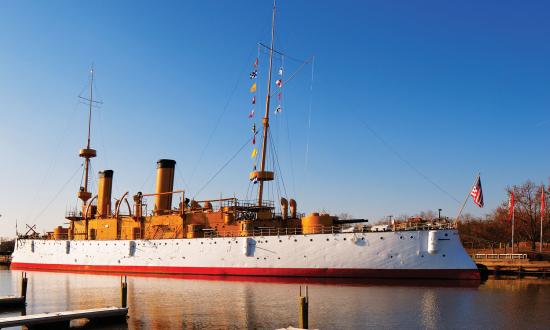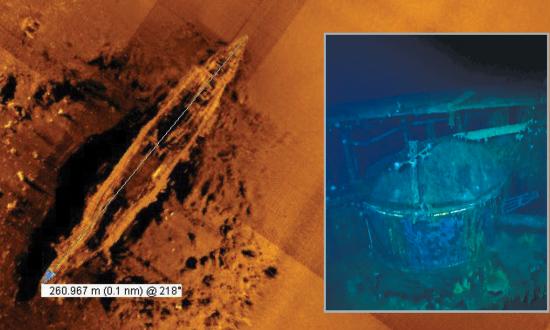Progress Continues on the National Coast Guard Museum.
As the U.S. Coast Guard celebrates its anniversary on 4 August, encouraging news emanates from New London, Connecticut, where progress continues to be made—despite the COVID-19 pandemic—on the future National Coast Guard Museum, slated to open in 2024.
To date, the National Coast Guard Museum Association has raised $56 million toward the $150 million required to build the museum. Both the association and the Coast Guard’s exhibit design team have maintained mission momentum throughout the coronavirus crisis.
“Even amid the disruption that social distancing has caused to our normal working routines, the Museum Association has continued to meet with donors virtually and to advance the permitting process with the state of Connecticut—a critical step to starting site preparation for the project,” said Captain Wes Pulver, U.S. Coast Guard (Retired), Museum Association president.
When the museum is completed, it will house more than 200 galleries and exhibits structured around five themed storylines: The Safety Deck will feature the “Lifesavers Around the Globe” wing, along with Coast Guard vessels. The Security Deck will feature the “Defenders of Our Nation” and “Enforcers on the Seas” wings. The Stewardship Deck will present the storylines of “Champions of Commerce” and “Protectors of the Environment.” As visitors explore the wings associated with each theme and walk through the STEM Discovery Center, they will be asked to solve problems, learn real skills, and interact with service members, both virtually and in person.
Indeed, “interactive” seems to be a salient goal, in keeping with what visitors expect as part of the modern museum-going experience. The Helicopter Hoist Rescue Simulator will place visitors in the middle of an airborne rescue at sea—one of the most daring actions of the Coast Guard. The Situation Analysis Simulator will challenge visitors to make split-second decisions based solely on what they see on the horizon from the bridge of a Coast Guard cutter. These experiences are geared toward inspiring the next generation of engineers, mathematicians, environmental scientists,
and Coast Guard members.
For more information on the National Coast Guard Museum, visit www.coastguardmuseum.org.
U.K. to Protect Sunken U.S. World War II Ships
The United Kingdom Department for Digital, Culture, Media and Sport, on the advice of Historic England, issued protections for two sunken U.S. tank landing ships (LSTs) located off Slapton Sands in Devon, the Naval History and Heritage Command reported on 4 May.
The announcement came 76 years after the sinking of LST-507 and LST-531 by German fast-attack craft, or E-boats, in April 1944 during Exercise Tiger. Tiger was a training exercise aimed at preparing American and British troops for the Utah Beach assault forces. More than 700 U.S. servicemen lost their lives during the exercise.
“The underwater remains of ships involved in the D-Day rehearsals are a tangible reminder of the sacrifices made in planning and delivering this huge military operation on a scale never previously attempted, 76 years ago,” said Duncan Wilson, chief executive of Historic England. “By protecting the wrecks of two U.S. landing ships, we are remembering all of those who lost their lives in the struggle for liberty during the Second World War.”
Trafalgar Chronicle Issues Call for Papers
For three decades, the Trafalgar Chronicle has been the flagship scholarly publication of the 1805 Club, a nonprofit organization with an international membership. Its mission is to preserve the history, heritage, memorials, and monuments of the Royal Navy during the Georgian Era (the period of “Nelson’s Navy”), from approximately 1775 to 1830. The Trafalgar Chronicle, a component of that mission, is published annually by Seaforth Publications.
For the 2021 edition, the editors seek carefully researched articles on “Georgian Navy Encounters with Indigenous Cultures and Enslaved Populations”—research and analysis of how the Georgian Navy interacted with, influenced, and was influenced by native populations and slaves. Contributors are invited to consider the long-term effects of these encounters, positive and negative.
Additional topics are being sought as well: general-interest articles with some unique perspective on the Georgian Navy, from biographical articles to articles about major wars, battles at sea, and technological advances in the Age of Sail. Reports on preservation efforts regarding the artifacts, graves, memorials, and monuments of the Nelson era also are welcome.
Interested contributors should submit a proposal/abstract of no more than 500 words and a biographical synopsis of no longer than 150 words. Proposals are due by 1 September 2020. Applicants will be notified of acceptance status by 1 October 2020. Detailed author guidelines are available on request and will be sent to each author in any case when a proposal is accepted. Submit all proposals and inquiries
to tc.editor@1805Club.org.
Wreck of Battleship Nevada Located
Underwater archaeologists on 11 May announced the discovery of the USS Nevada (BB-36), one of the U.S. Navy’s longest serving battleships, 65 nautical miles southwest of Pearl Harbor at a depth of more than 15,400 feet.
The discovery was the result of a collaboration between the SEARCH maritime archaeology team and the marine robotics company Ocean Infinity, with the mission jointly coordinated between SEARCH’s operations center and the Ocean Infinity vessel Pacific Constructor. The Pacific Constructor had set sail for a range of commercial tasks in the Pacific in early 2020, ahead of the COVID-19 pandemic. As a result of the global health crisis, the ship remained at sea, and from that exigency emerged a unique “social distancing” shipwreck-hunting success story, as archaeologists on land worked remotely with the robotics crew at sea.
And what they found was a ship of legend. From service in World War I to suffering the bombardment of Pearl Harbor, to service in the Normandy Invasion, at Iwo Jima, and at Okinawa, to her final fate as a target during atomic bomb testing in 1946, the Nevada had a storied career, spanning three and a half decades.
Launched in 1914, she performed escort duties for convoys headed to the British Isles. At the end of World War I, she escorted the ocean liner George Washington, carrying President Woodrow Wilson to attend the Paris Peace Conference.
In the 7 December 1941 attack on Pearl Harbor, the Nevada was the only battleship to get under way, but having been struck by five bombs, she finally sank in nearby shallow waters. During this action, 60 of her crew were killed and 109 wounded.
Following salvage operations, she soon rejoined the war effort, taking part in the D-Day landings, among other European operations. She then returned to the Pacific, arriving off Iwo Jima in February 1945, and played an important part in the invasion of Okinawa. After World War II, the Nevada was assigned to be a target ship in the first Bikini atomic experiments in 1946, which she survived. Finally, in 1948, she was used as a gunnery practice target. Unable to be sunk by the ships using her as a target, she finally went down after being hit by an aerial torpedo on 31 July 1948.
James Delgado, SEARCH’s senior vice president and lead maritime archaeologist on the mission, noted, “Nevada is an iconic ship that speaks to American resilience and stubbornness. Rising from her watery grave after being sunk at Pearl Harbor, she survived torpedoes, bombs, shells, and two atomic blasts. The physical reality of the ship, resting in the darkness of the great museum of the sea, reminds us not only of past events, but of those who took up the challenge of defending the United States in two global wars. This is why we do ocean exploration—to seek out these powerful connections to the past.”







